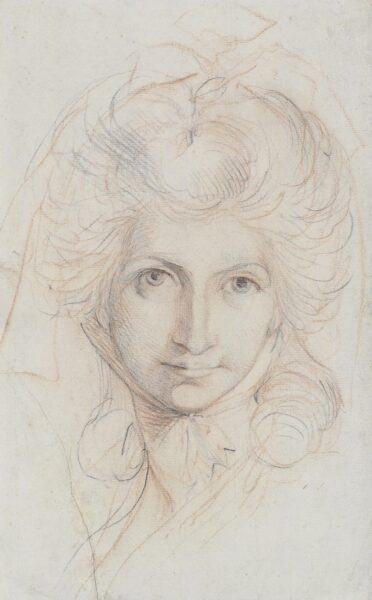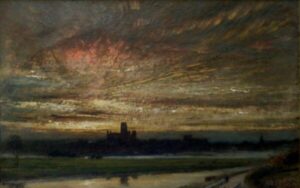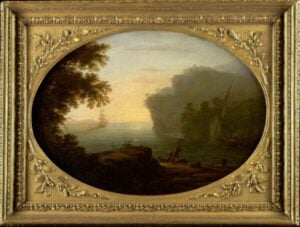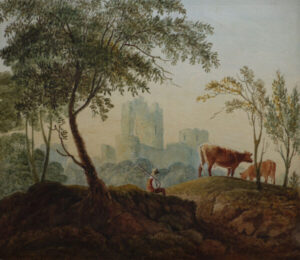Description
The following text has been transcribed from Christie’s sale catalogue.
The sitter is probably Magdalena Hess, niece of Johann Kaspar Lavater (1741-1801), Fuseli’s boyhood friend. In 1763, following an altercation with the son-in-law of a local Burgomaster, Fuseli accompanied by Lavater and Felix Hess (1742-1768) left Zurich and travelled to Germany. While there, they met Sir Andrew Mitchell (1708-1771), English Chargé ďAffaires in Berlin, who invited Fuseli to accompany him back to England in order to help further the connection between German and English literary worlds. Fuseli only returned once to his native country, when he spent six months in 1778 renewing his friendship with family and friends especially Hess and Lavater.
It was during this trip that Fuseli met and became friendly with Magdalena and her sister Martha. He executed a number of portraits of the sisters including drawings now in the Kunsthaus, Zurich and in Schlossmuseum, Weimer (G. Schiff, Johann Heinrich FÜssli 1741-1825. Zurich and Berlin, nos. 573-80).
Magdalena was married to the philanthropist, philosopher and radical thinker Johann Caspar Schweizer and was no less eccentric than her husband. Martha on the other hand was more ethereal and tended towards religious ecstasy. She died of consumption shortly after Fuseli left Zurich in 1779.
We are grateful to Dr. Weinglass for suggesting the present drawing dates from 1802, when many English travellers made their way to Paris, following the peace of Amiens. Joseph Farington (1747-1821) who was of the party refers to Fuseli’s visits to the suburbs to see his friends. The present sitter shows the same heart-shaped face, the straight nose and the chin of Martha Hess but is older and more self-possessed and striking presence, hence her possible identification as Martha’s oldest and last surviving sister Magdalena (d.1814).
Lavater, who became a noted phsiognomist used some of Fuseli’s drawings of Hess sisters to illustrate the English edition of his Essay on Physiognomy (published 1789-98), with which Fuseli was deeply involved, supervising the translation and the engravings and writing an introduction.
We are grateful to Martin Butlin for confirming the attribution to Fuseli upon firsthand inspection and to Dr. H. Weinglass, Emeritus Professor, University of Missouri-Kansas City, for confirming the attribution upon a photograph and for providing us with additional catalogue information.
Brand
Fuseli, Henry (1741-1825)
Fuseli was born in Zurich on 6 February 1741, the second son of the five children of Johann Caspar Füseli and Elisabeth Waser. Although educated as a theologian and ordained as a Zwinglian minister in 1761, Fuseli pursued a wide range of humanist studies, developing an enthusiasm for classical philology under the influence of Johann Jakob Breitinger, and becoming proficient in English, French, and Italian. He was introduced by Johann Jakob Bodmer, the mentor whom he most revered, to Homer, the Nibelungenlied, Dante, Shakespeare, and Milton, later the principal sources of his art. His associations with the Sturm und Drang movement were close.
Forced, with Lavater, to leave Zurich in 1763 after publishing a pamphlet critical of the administration, he traveled in Germany, England, and France, embarking on a literary career. Encouraged by Reynolds in 1768 to become a painter, Fuseli traveled to Italy in 1770 in the company of John Armstrong. He sought inspiration from classical sculpture, Michelangelo, and mannerist art, and, befriended by the Swedish sculptor Johan Tobias Sergel, became the leading spirit of a group of innovative young artists.
Returning to London in 1780, Fuseli established his reputation with The Nightmare. Involved from the outset in 1786 with John Boydell's scheme for employing the most talented artists of the day on a Shakespeare Gallery, he devoted most of his time to paintings of Shakespearean themes until the opening of the gallery in 1789. In emulation of this project, he executed during the 1790s forty-seven paintings for a Milton Gallery in which the work was entirely his. Although many of these works were bought by his principal patron, Thomas Coutts, the exhibitions in 1799 and 1800 were not a public success. Fuseli was elected an Associate of the Royal Academy of Arts in 1788, a full Academician in 1790, and Professor of Painting in 1799; he was obliged to relinquish the latter post after his election as Keeper in 1804, the year in which Benjamin Robert Haydon became his pupil, but the statutes were altered to allow him to resume it in 1810.
Fuseli's relationships with and attitude to women were highly important for his art. His most passionate love was for Anna Landolt, a niece of Lavater, whom he met in Zurich in 1778; but her father refused his suit. He married in 1788 Sophia Rawlins, an attractive young model obsessed with hair and fashion, who was socially and intellectually his inferior; there were no children, but she appears to have satisfied her husband's fetishistic and other desires. Mary Wollstonecraft's passion for him in 1792 was firmly put down by Mrs. Fuseli. Fuseli died suddenly on 16 April 1825, at the home on Putney Hill of Coutt's daughter, Lady Guilford, and was buried in Saint Paul's Cathedral, London. [This is an edited version of the artist's biography published, or to be published, in the NGA Systematic Catalogue]




